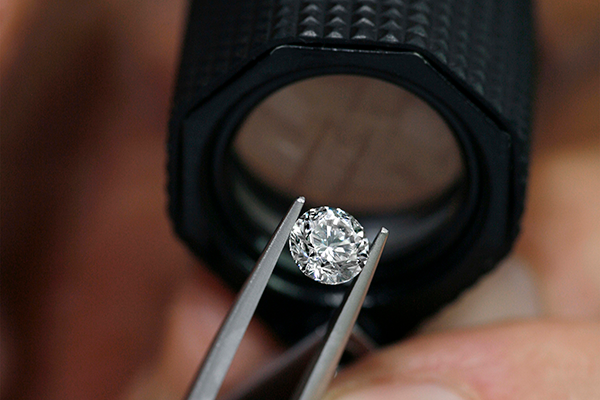
Credits: www.igi.org
I challenge you to remain impassive in front of the sparkle of a beautiful diamond! In fact, humanity has always been fascinated by everything shining, in particular gold and precious gems.
Diamonds occupy a special place in the hearts of the people, who for decades have been accustomed to associating them with love. Approximately 80% of engagement rings are made up of a central diamond. However, given their scarcity, their cost can be prohibitive for a young couple and this is where lab diamonds come into play. In fact, there are different types of diamonds and also not all diamonds are created the same way.
Today we talk about synthetic diamonds (created in the laboratory) and try to understand the differences between the latter and natural diamonds (extracted in mines).
Let’s start from the basics: what is a diamond?
What is a diamond?
Diamonds are carbon atoms arranged in a crystal structure.
They formed about 200 km below the earth’s surface, 1 – 3 billion years ago, under conditions of extreme pressure and heat that caused the carbon atoms to crystallize. These temperatures vary between 1,000 – 3,000°C and the pressure is approximately 137,000 higher than that felt on the earth’s surface.
The volcanoes then trapped the diamonds in their lava, which, exploding upwards, brought the diamonds closer to the earth’s crust, from which we can extract them today.
Diamonds are the hardest minerals in the world, indeed they must be to withstand the volcanic activities and earth movements that move them from the mantle to the crust.
The diamond industry as we know it today began in Africa in 1866, when the first deposit was discovered.

Credits: www.naturaldiamonds.com
What is a lab-grown diamond?
Unlike a “natural” diamond, which was formed deep within the earth, a diamond is defined as “lab-grown” when it is created in a laboratory.
It should not be confused with diamond alternatives such as moissanite, cubic zirconia or white sapphire. All of them might look like colorless diamond, but from a chemical point of view they are actually completely different stones.
The first attempts to create a diamond in laboratory date back to the 1950s, for industrial purposes. In the following decades, researchers increasingly implemented machineries and techniques until obtaining quality gems in the 2000s.
The two main processes for the production of diamonds in the laboratory are:
HTHP (High Pressure High Temperature): HTHP (High Pressure High Temperature): technicians fill a capsule with pure carbon and a metallic flux, adding a very small diamond, called “seed”. This seed represents the surface on which the new diamond will form. When the capsule is filled and sealed, same is then subjected to intense heat (1300 – 1600°C) and enormous pressure (roughly equivalent to the pressure exerted by a commercial airplane when balanced on the tip of your finger), to replicate the same conditions that a diamond would have been subjected to in nature. The carbon in the capsule dissolves and then crystallizes around the seed.
Diamonds produced with this system can be used for jewelry, but most of them are intended for industrial purposes.
Mediocre quality diamonds (both natural and synthetic) might undergo this process to improve their color. In addition to making diamonds “colorless,” this method is also used to change the color of a diamond to pink, blue or yellow.
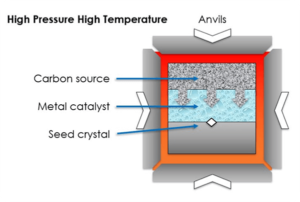
Credits: www.igi.org
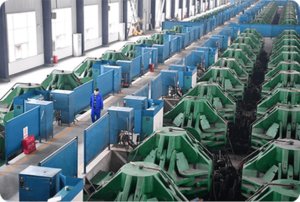
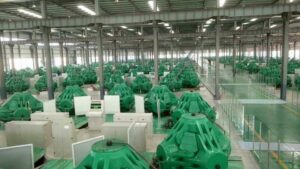
Credits: www.igi.org Credits: www.beldiamond.com
CVD (Chemical Vapor Deposition): a diamond seed is introduced into a special chamber, inside which a carbon-rich gas is pumped. The chamber is heated (temperatures here are more moderate and are around 700 – 1300°C) and the carbon atoms are separated using an electric discharge or microwave energy. When the carbon atoms leave the gas, they gather around the diamond seed. Part of the carbon crystallizes around the seed, while the remainder turns into graphite, so technicians occasionally have to interrupt the process to remove it and polish the diamond.
Most diamonds obtained by this method are suitable for jewelry.
The size of the new diamond depends on how long the process takes.
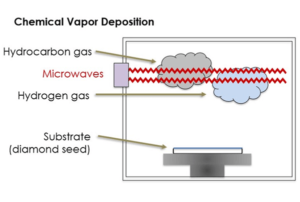
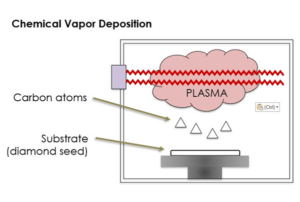
Credits: www.igi.org Credits: www.igi.org
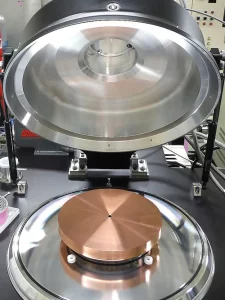
Credits: www.beldiamond.com
With both methods, you can get a diamond in just 2 – 4 weeks. At the end of the process, the gem is cut and polished, just like any other natural diamond.
How are lab-grown diamonds graded?
After the cutting process, but prior to the setting into a jewel, the lab-grown diamond must submitted to a third-party and impartial gemological institute (e.g. GIA, IGI, etc.) for quality assessment.
In order to establish the origin of the diamond, gemologists use extensive tests and sophisticated tools that analyze fluorescence, phosphorescence, inclusions and other factors that determine the difference between natural and lab-grown diamonds.
The institute will then have to produce a certification, stating the origin of the diamond (the laboratory) and the evaluation of the famous diamond qualitative parameters, i.e. the 4Cs (carat, purity, colour, cut). Finally, scientists must also be able to establish whether the diamond has been submitted to treatments in order to improve its color or to acquire color (yellow, pink, green, blue).
It is important that the institution issues the certification on a special cardboard with particular colors, so as to distinguish from the natural diamond certifications. The aim is to highlight (from the cover to the internal wording) that the document refers to a lab-grown diamond.
A final and very important precaution adopted by certification institutes to protect consumers is the laser inscription on the diamond girdle of both the certification serial number and the wording “Lab-Grown”.
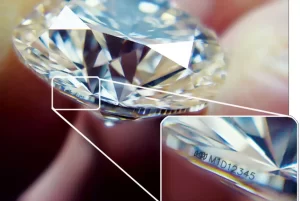
Credits: www.igi.org
Are lab-grown diamonds real diamonds? What is the difference between a natural diamond and a lab-grown one?
From the chemically, visual and physical point of view, lab-grown diamonds are identical to mined ones. It is absolutely impossible to distinguish a natural diamond from a lab-grown with the naked eye.
The only “technical” differences between the two are the origin (earth mantle – laboratory) and the time necessary for creation (billions of years – weeks).
Furthermore, since the conditions in which the two kind of diamonds form are very different, the presence of nitrogen is a distinguishing characteristic: natural diamonds have a small amount of nitrogen, while lab-grown diamonds have none.
Therefore, in order to evaluate the nature of a diamond, it must be submitted to an in-depth gemological examination, using specific machinery. Consumers are invited to carefully check the quality certificate, which must clearly report all the diamond characteristics, including its formation process.
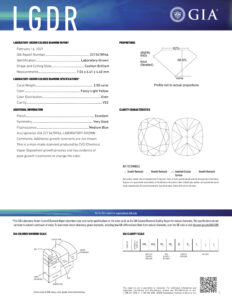
Credits: www.gia.edu
Where are lab-grown diamonds produced?
Lab-grown diamonds are produced almost everywhere in the world. Currently, about half of lab-grown diamonds are produced in China.
United States, India and Singapore produce approximately 10-15% of the total.
In many Chinese and Indian laboratories, laborers work long hours for little pay, and many laboratories are unwilling to disclose the amount of energy used to produce their diamonds.
Finally Russia and the United Kingdom and a few other nations reach 2% of production.
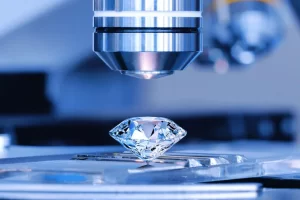
Credits: www.beldiamond.com
Where are natural diamonds mined?
Natural diamonds are found in around 30 countries in the world.
Russia has the largest reserve of natural diamonds in the world, which is around 1,000 million carats, although their use is predominantly industrial. After the outbreak of war against Ukraine, Russia’s exports to countries opposed to the war stopped.
Another extraordinary diamond reserve is in Botswana, counting around 300 million carats. Diamonds coming from Botswana mines are high quality and command the price in the jewelry market.
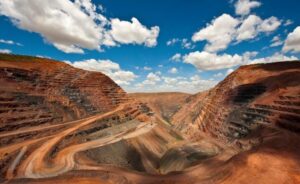
Credits: www.beldiamond.com
Are natural and lab-grown diamonds eco-sustainable and ethical?
What is the environmental impact of natural diamonds compared to lab-grown ones?
Many important companies have been committed for years to promoting the traceability of every natural gem used in their creations.
For example, Tiffany & Co. has a website page dedicated to their sustainability projects.
The De Beers Group has been working side by side with the Botswana government for years in order to manage diamond mining, which represents 25% of the country’s gross domestic product. For every hectare excavated, De Beers is committed to donating 6 acres of land for conservation, ecosystems and research. Furthermore, it creates jobs and promotes programs for female employment within the diamond industry, including roles such as managers, engineers, geologists.
The Italian Recarlo has obtained the Responsible Jewelry Council certification (which aims to create a sustainable supply chain at every stage), purchases diamonds coming exclusively from countries adhering to the Kimberly Process, which ensures the origin of the diamonds from controlled mining locations and launched the “Our promise to you” plan in 2021 in collaboration with Eco-Age consultancy company, founded by Livia Firth to guarantee the traceability of raw materials, environmental protection and workers’ rights and attention to local communities.
The Kimberley Process is committed to ensuring and certifying ethical mining practices, to abolish so-called “blood diamonds”, but nevertheless many people still associate natural diamonds with wars and conflicts.
Thus, in addition to the lower price, the ethical motivation seems to be at the basis of the young Millenials interest towards lab-grown diamonds. Marketing campaigns label them as more “eco-friendly” than natural diamonds, underlining how the latter finance military conflicts in numerous countries. This information is not entirely correct. Mining can certainly damage the environment (just imagine that extraction of one carat diamond needs to move approx. 200 tons of soil), however the majority of mines operate in such a way as to meet – and sometimes outdo – the standards internationally required, getting better production techniques and adopting new practices that protect and improve environmental conditions. Mining companies invest in activities that improve the living conditions of miners and the cities in which they live, providing education, healthcare and infrastructure. If the market for natural diamonds collapsed, millions of fair-trade workers would find themselves out of work and at risk of poverty.
Lab-grown diamonds ensure no conflict or mistreatment for local workers, but require a massive amount of energy, most of which comes from non-renewable sources, thus contributing to the greenhouse effect and global warming.
A few lab-grown diamond laboratories have distinguished themselves by using clean energy, but this is still a small number of producers. Until laboratories show clear and verifiable proof of the use of renewable energy (solar, hydroelectric, wind), lab-grown diamonds cannot be considered a truly ecological option.

Credits: www.naturaldiamonds.com
What makes a diamond sustainable?
The definition of sustainability must take into consideration the production process, but also the general impact that the diamond has on the environment and on the lives of populations, therefore the ethical and social aspects must be considered.
If you choose to purchase a natural diamond, make sure it has Kimberley Process certification.
If you choose a lab-grown diamond, rely on a trusted jeweler who sells gems from responsible sources.
Why are natural diamonds more expensive?
It’s true, natural diamonds cost more than lab-grown for several reasons.
First of all, they are highly valued because they are rare gems formed billions of years ago, hundreds of kms beneath the earth’s crust. Only 30% of mined diamonds possess the qualities suitable for jewellery purposes, so the number of available diamonds is limited and each is rightly considered a rarity. Their scarcity and the extreme conditions through which they were form make them extremely precious.
Furthermore, it is difficult to find diamond mines, as well as extremely expensive to extract the gems (think about excavations, machinery, labor). The journey that a diamond takes to get to the jeweler’s counter is really long and it also has a cost.
Lab-grown diamonds, on the other hand, are produced in a laboratory. The improvement of technologies and the increase in their production make them economically advantageous, so much so that it is estimated that their value is approximately 20% – 30% less than natural ones. However, it is reasonable to hypothesize that in the long term, producers could decide to stabilize the price, as similarly happened for natural diamonds.
What kind of diamond should I choose? Pros and cons
Both natural and lab-grown diamonds arise from a complex creation process that has an impact on the environment and the populations that produce them. Both have their baggage of benefits and prejudices.
No choice that is better than another, just remember that the ring you choose must reflect (and respect!) your story in a unique and significant way and must also arise emotions in you.
To facilitate your evaluations, I summarize the pros and cons of both here below:
LAB-GROWN DIAMONDS
PRO’S
- less expensive than natural diamonds;
- chemically, visually and physically identical to natural diamonds;
- ensure a conflict-free production process;
- origin and provenance is certain.
CON’S
- new production techniques can replicate them infinitely, causing their value to decrease over time;
- if they are low quality, they might become yellowish or brownish and require bleaching;
- their production requires a lot of energy and most of these diamonds are produced with non-renewable energy sources in low-wage countries.
NATURAL DIAMONDS
PRO’S
-
- they require billions of years to form and their characteristic scarcity makes them precious over time;
- because they were formed in the earth, they have greater emotional value and historical appeal;
- they play the important role of primary source of income in many societies;
- mining companies are actually engaged in ethical activities.
CON’S
- they are more expensive because the supply is limited;
- mining can be harmful to the environment, although companies increasingly strive to improve mining operations and the living conditions of workers;
- the origin is not always certified or guaranteed, especially for antique diamonds, which have been marketed and/or cut several times.
There are retailers who offer lab-grown diamonds as natural, or who do not reveal the treatments they have been submitted to. Therefore I recommend once again that you rely on a respectable and extremely trustworthy jeweller, who can explain the characteristics of the various diamonds on display, so that you can make decisions based on complete and correct information.
On a final note, I would like to suggest a third option for truly green-hearted people: antique diamonds. The gems mounted on ancient jewels are obviously natural, since in the past modern production techniques did not exist, with all the environmental consequences that we have listed above. However, this type of purchase promotes sustainability because it does not involve new resources to mine or incur transportation costs.
Furthermore, the human cost, in terms of possible deprivations of rights, has already been paid once and it decreases with each change of ownership.
The choice of an antique object, in addition to having an undoubted charm, saves tons of CO2 and is ethical because it extends the life of a beautiful, high-quality product.
What are the most famous brands that use lab-grown diamonds in their creations?
More and more high jewelry brands are approaching the world of lab-grown diamonds. Here is a short list of reliable companies with the very interesting collections:
Blue Nile https://www.bluenile.com/diamonds/lab-grown-diamonds
Brilliant Earth https://www.brilliantearth.com/lab-diamonds-search/
Clean Origin https://www.cleanorigin.com
Grown Brilliance https://www.grownbrilliance.com
Helzberg https://www.helzberg.com/engagement-rings/lab-grown-diamond-engagement-rings
James Allen https://www.jamesallen.com/lab-created-diamonds/
Jean Dousset https://jeandousset.com/collections/engagement-rings
Lightbox (De Beers) https://lightboxjewelry.com/
Ritani https://www.ritani.com/pages/lab-grown-diamonds
Tacori https://www.tacori.com/engagement-rings/
Vrai https://eu.vrai.com/
e l’italianissimo:
Inbili.co https://www.inbili.co
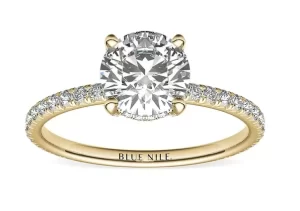
BLUE NILE, Credits: www.theknot.com
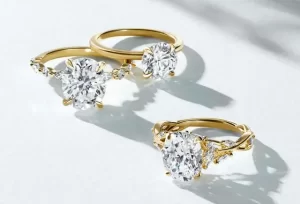
BRILLIANT EARTH, Credits: www.brilliantearth.com
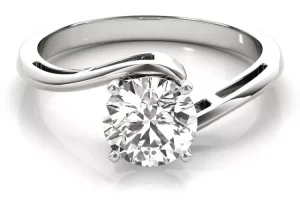
CLEAN ORIGIN, Credits: www.brides.com
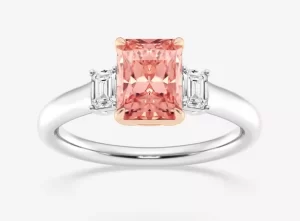
GROWN BRILLIANCE, Credits: www.brides.com
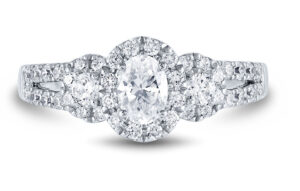
HELZBERG, Credits: www.helzberg.com
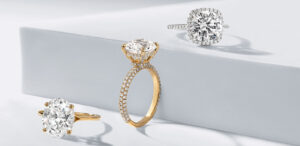
JAMES ALLEN, Credits: blog.jamesallen.com
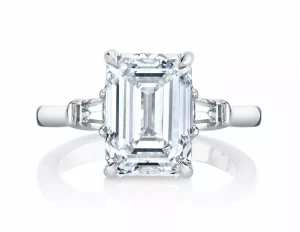
JEAN DOUSSET, Credits: www.theknot.com
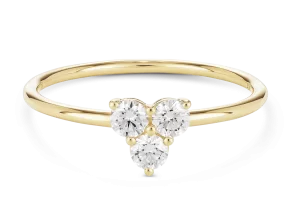
LIGHTBOX, Credits: lightboxjewelry.com
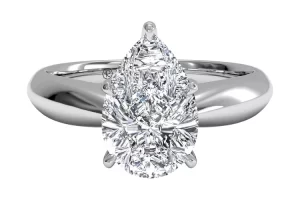
RITANI, Credits: www.brides.com
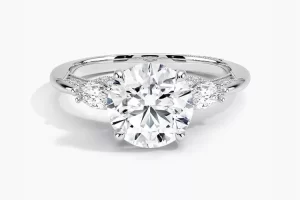
TACORI, Credits: www.brides.com
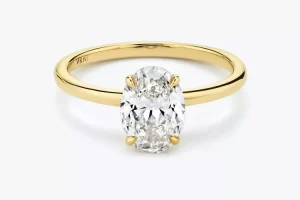
VRAI, Credits: www.brides.com

INBILI.CO, Credits: inbili.co.
Sources:
4cs.gia.edu
www.igi.org
www.theknot.com
theadventurine.com
www.naturaldiamonds.com
www.rivistaitalianadigemmologia.com
jewelrytalk.com
www.vogue.com
www.antiquesforeveryone.co.uk/
www.brides.com
www.beldiamond.com


